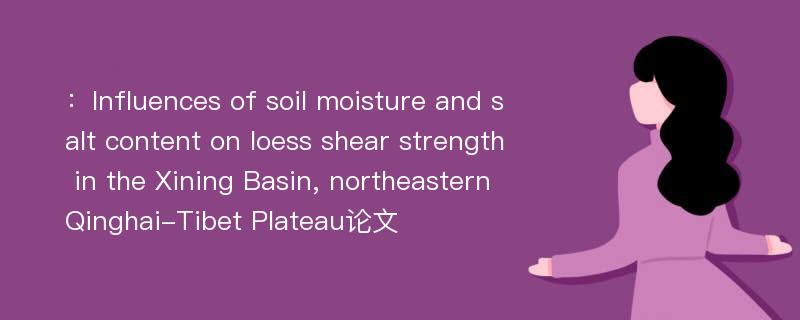
本文主要研究内容
作者(2019)在《Influences of soil moisture and salt content on loess shear strength in the Xining Basin, northeastern Qinghai-Tibet Plateau》一文中研究指出:Moisture and salt content of soil are the two predominant factors influencing its shear strength. This study aims to investigate the effects of these two factors on shear strength behavior of loess in the Xining Basin of Northeast Qinghai-Tibet Plateau, where such geological hazards as soil erosion, landslides collapse and debris flows are widespread due to the highly erodible loess. Salinized loess soil collected from the test site was desalinized through salt-leaching in the laboratory. The desalinized and oven-dried loess samples were also artificially moisturized and salinized in order to examine how soil salinity affects its shear strength at different moisture levels. Soil samples prepared in different ways(moisturizing, salt-leaching, and salinized) were measured to determine soil cohesion and internal friction angle. The results show that salt-leaching up to 18 rounds almost completely removed the salt content and considerably changed the physical components of loess, but the soil type remained unchanged. As salt content increases from 0.00% to 12.00%, both the cohesion and internal friction angle exhibit an initial decrease and then increase with salt content. As moisture content is 12.00%, the salt content threshold value for both cohesion and internal friction angle is identified as 3.00%. As the moisture content rises to 16.0% and 20.00%, the salt content threshold value for cohesion is still 6.00%, but 3.00% for internal friction angle. At these thresholds soil shear strength is the lowest, below which it is inversely related to soil salinity. Beyond the thresholds, however, the relationship is positive. Dissimilar to salinity, soil moisture content exerts an adverse effect on shear strength of loess. The findings of this study can provide a valuable guidance on stabilizing the engineering properties of salinized loess to prevent slope failures during heavy rainfall events.
Abstract
Moisture and salt content of soil are the two predominant factors influencing its shear strength. This study aims to investigate the effects of these two factors on shear strength behavior of loess in the Xining Basin of Northeast Qinghai-Tibet Plateau, where such geological hazards as soil erosion, landslides collapse and debris flows are widespread due to the highly erodible loess. Salinized loess soil collected from the test site was desalinized through salt-leaching in the laboratory. The desalinized and oven-dried loess samples were also artificially moisturized and salinized in order to examine how soil salinity affects its shear strength at different moisture levels. Soil samples prepared in different ways(moisturizing, salt-leaching, and salinized) were measured to determine soil cohesion and internal friction angle. The results show that salt-leaching up to 18 rounds almost completely removed the salt content and considerably changed the physical components of loess, but the soil type remained unchanged. As salt content increases from 0.00% to 12.00%, both the cohesion and internal friction angle exhibit an initial decrease and then increase with salt content. As moisture content is 12.00%, the salt content threshold value for both cohesion and internal friction angle is identified as 3.00%. As the moisture content rises to 16.0% and 20.00%, the salt content threshold value for cohesion is still 6.00%, but 3.00% for internal friction angle. At these thresholds soil shear strength is the lowest, below which it is inversely related to soil salinity. Beyond the thresholds, however, the relationship is positive. Dissimilar to salinity, soil moisture content exerts an adverse effect on shear strength of loess. The findings of this study can provide a valuable guidance on stabilizing the engineering properties of salinized loess to prevent slope failures during heavy rainfall events.
论文参考文献
论文详细介绍
论文作者分别是来自Journal of Mountain Science的,发表于刊物Journal of Mountain Science2019年05期论文,是一篇关于,Journal of Mountain Science2019年05期论文的文章。本文可供学术参考使用,各位学者可以免费参考阅读下载,文章观点不代表本站观点,资料来自Journal of Mountain Science2019年05期论文网站,若本站收录的文献无意侵犯了您的著作版权,请联系我们删除。
